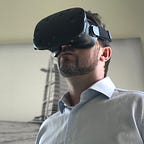From “Consume” to “Experience” — how VR offers a new way for students to engage with learning
When it comes to education technology, one of the most prevalent concepts is the idea that students need to create rather than just consume content. This has become more important in the era of mobile technology amid fears that students could become mindless content-zombies staring at iPad screens. A true 21st Century educator will enrich the curriculum with well-considered technology integration that harnesses creative tools to redesign the learning opportunities afforded to students. From green-screen film-making to podcasting to stop-motion animation, the range of creative activities that students can engage with has grown exponentially over the past five years.
So one of the questions I get asked at conferences these days is, “Isn’t VR just for another way to consume content?” I can understand where this thinking comes from, especially since at this point in time, most educators have had limited exposure to virtual reality. Many have only tried mobile VR headsets using applications like Google Expeditions or Nearpod which harness 36⁰⁰ images in a stereoscopic view. Whilst these apps are great tools for the classroom (they frame the content with well-considered pedagogy), they don’t represent the true VR experience afforded by apps that boast 6DOF, room-scale environments or user interaction. I do believe that part of the reason some educators see VR as a content consumption device is that they are yet to appreciate a fully-immersive virtual reality experience.
VR offers a completely new way for students to engage with learning content that transcends the traditional concept of consumption vs creation. Experiential learning through VR allows students to engulf themselves in the content, making a visceral connection with it and often having a more emotive response. Here’s an example from the school I work at, JESS Dubai, where we used the Timelooper application to transport students back in time to stand in Trafalgar Square during The Blitz of World War Two. Listen to the feedback from the educators I worked with on this project but also pay attention to the reactions captured from the students — many of whom cite this as the most powerful learning experience that they have had this year:
When it comes to comparing consumption-based learning to experiential learning, the example I often refer people to is that of learning to drive a car. When I stepped out of my parents’ front door for my first driving lesson at the age of 17, I was genuinely shocked that I was expected to get straight into the driver’s seat. I actually thought that the instructor was joking! How could I drive when I hadn’t learned how to yet? The simple fact is that we can’t learn to drive by reading books about it, watching videos about it or even making a multimedia presentation about it. We just have to do it. We learn through the experience and the emotive response (in the case of learning to drive, this is usually fear) tempers our ability to connect with the learning and in turn our ability to retain the crucial information.
VR now offers the ability for students to engage with learning in a similar way. This can include the development of vocational skills, meta-cognitive skills and the understanding of curriculum content. This is how I have approached the integration of VR across JESS Dubai over the last couple of years. Our sports science students need to learn about the way the heart works? Let’s put them inside a beating human heart using YOU by ShareCare — an learning experience identical to one Wade Watts describes in Ready Player One. Our Year 5 students are learning about the Amazon? Let them drop into the rainforest by parachute and explore the wildlife up close and personal using Amazon Odyssey. The Astronomy Society are learning about Mars? Time for a field trip using Engage to let them get a close-up look at the red planet (and take a lot of selfies!)
We create powerful, meaningful learning experiences using VR every day at JESS, experiences that go far beyond content consumption. I’m going to finish off with one last example from our DT department. Some of our Year 10 students recently took part in a competition hosted by the Dubai Institute of Design and Innovation. From the range of project briefs on offer they chose to design the car showroom of the future and used Google SketchUp as their medium. To help them with the iteration process, I gave them access to Kubity which allows designers to step inside SketchUp models in VR. The experience was rewarding for them as it allowed them to experience their design at human-scale and identify design flaws that would have been much harder to pick up on via a regular PC screen. I’ll leave you with this short clip of the students in action:
You can find a host of other VR clips on the JESS Dubai YouTube channel and follow @JESSDubai and @JESSdigitalUAE on Twitter to keep up to date with all the best in digital learning and innovation from across the school.
Steve shares content related to AR and VR in education freely via his website VirtualiTeach. He also hosts free professional development sessions for educators across the globe INSIDE virtual reality each month. Find out more about these events here.
